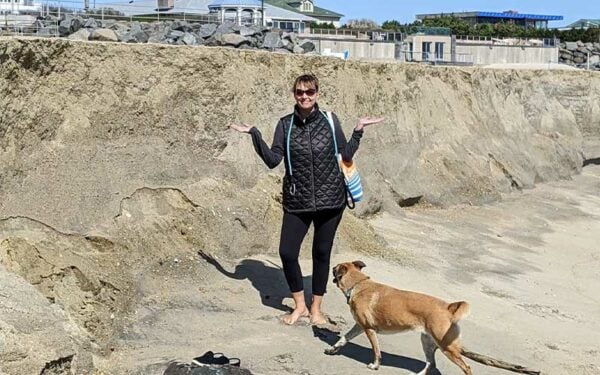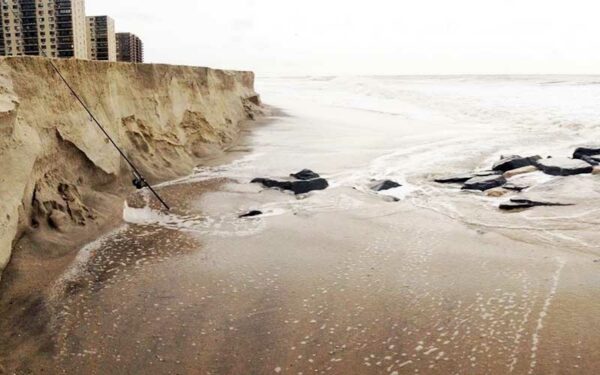TOMS RIVER, NJ – The New Jersey Coastal Alliance today said the U.S. Army Corps of Engineers beach replenishment work at the Jersey Shore is causing more harm than good as mayors up and don’t the coast clamor for another round of sand this week.
A Mother’s Day nor’easter washed tons upon tons of sand from the Jersey Shore from Cape May to Sandy hook, leaving many beaches with steep high cliffs and narrow beaches, despite a recent major beach replenishment project by the U.S. Army Corps of Engineers.
The hardest hit was Ortley Beach, a beach town that was ground zero during Superstorm Sandy. It was also the site where local officials are now saying a sinkhole swallowed and killed a teen digging in the sand with his sister earlier this week.
Related: Officials Say Sinkhole Swallowed Teen Who Died at Toms River Beach Caused by Unstable Sand
The mayor of that town, Maurice Hill immediately shook his fist in the air at the Army Corps of Engineers to fix it, but the federal government has rejected his request. 25% of the public beach access in Ortley Beach will be closed for Memorial Day. Hill is now seeking emergency funding to dump more sand on the beach, a move the New Jersey Coastal Alliance says might not be the best move.

“The press has been covering dangerous beach conditions created in the wake of coastal storms. These have resulted in the formation of sand cliffs. This is often referred to in these articles as erosion caused by storms. However, we believe the Army Corps of Engineers’ work has caused this situation, not coastal storms,” the alliance said today. “Our beaches normally have offshore sandbars that run parallel to the beach. There may be 2 or more of these bars as you go out from shore, each deeper than the next. As ocean swells some rolling in, the rule is that these swells break into waves when they reach a water depth less than 1.3 times the swell height.”
The destruction of these offshore sandbars is creating harsher conditions at the shoreline, the group says, which is causing more erosion than before the federal beach replenishment project.
“On a gentle day the swells can be 2 feet high and break close to shore. But bigger, more powerful swells as high as 8-10 feet break far out from shore when they reach the outermost sandbar, expending their energy there,” the group claims.
“Today, the Army Corps projects have buried these sandbars, creating a beach profile that goes from dry beach to deep water very quickly. The waves roll in, unbroken, with all their power intact. The waves carve at the beach face, creating sand cliffs, and cutting back at the new wall of sand. You see the result in the attached photos,” said Ross Kushner, of the Alliance. “Eventually the ocean will recreate the sandbars, but it takes years. Often just in time for the next “replenishment” project to destroy them,”

Kushner said all you have to do is look at New Jersey’s natural beaches like Island Beach State Park which have been free of meddling from development and restoration. Instead, beach dunes grow naturally and the offshore topography is designed by nature.
“So, we believe this “erosion” has little to do with storms. Visit a more natural beach such as Island Beach State Park or Sandy Hook and little damage from these storms occurs. We must stop blaming the ocean for conditions that may be actually created by the Army Corps at a cost of hundreds of millions,” Kushner added.
“As for sinkholes like the one in Toms River, Kushner and his group believe those problems are manmade,” he said. “We are certain these sinkholes are a function of the Army Corps beach replenishment. From our standpoint, this work is performed in the cheapest, fastest way, not the safest. Their goal is to fulfill a contract, not to provide a safe, quality experience for the beach-going public.”
Kusher also said hazardous sand cliffs are a signature feature of beaches that have been newly replenished by the Army Corps of Engineers.
“These are rare where Army Corp projects have not changed the structure of the beach,” he added. “Depositing enormous amounts of sand on a beach without properly compacting this material is a recipe for disaster. There are also the dangers posed by shore-break waves and the sudden appearance of sand cliffs.”
The problem is not specific to New Jersey either. In 2018, the Baltimore Sun warned of hazardous beach conditions caused by federal beach replenishment projects in Ocean City, Maryland.
“Some who watch the waves closely, including researchers and surfers, say the work can give the beach an unnatural profile that increases the risks of injuries and drownings,” the Sun reported. “There is no firm data to connect what is known as beach renourishment or replenishment to hazards, said Greg Dusek, a senior scientist with the National Oceanic and Atmospheric Administration’s National Ocean Service, but the engineering undoubtedly changes beaches’ shape and wave patterns. That requires swimmers and surfers to pay closer attention to rip currents or powerful waves that break directly on shore.”
